[English] 日本語
 Yorodumi
Yorodumi- PDB-7jmh: Functional Pathways of Biomolecules Retrieved from Single-particl... -
+ Open data
Open data
- Basic information
Basic information
| Entry | Database: PDB / ID: 7jmh | |||||||||||||||||||||||||||
|---|---|---|---|---|---|---|---|---|---|---|---|---|---|---|---|---|---|---|---|---|---|---|---|---|---|---|---|---|
| Title | Functional Pathways of Biomolecules Retrieved from Single-particle Snapshots - Frame 35 - State 4 (S4) | |||||||||||||||||||||||||||
 Components Components |
| |||||||||||||||||||||||||||
 Keywords Keywords | MEMBRANE PROTEIN / ion channel / Ca2+ channel / excitation/contraction coupling | |||||||||||||||||||||||||||
| Function / homology |  Function and homology information Function and homology informationpositive regulation of sequestering of calcium ion / negative regulation of calcium-mediated signaling / negative regulation of insulin secretion involved in cellular response to glucose stimulus / neuronal action potential propagation / negative regulation of release of sequestered calcium ion into cytosol / insulin secretion involved in cellular response to glucose stimulus / response to redox state / 'de novo' protein folding / negative regulation of heart rate / FK506 binding ...positive regulation of sequestering of calcium ion / negative regulation of calcium-mediated signaling / negative regulation of insulin secretion involved in cellular response to glucose stimulus / neuronal action potential propagation / negative regulation of release of sequestered calcium ion into cytosol / insulin secretion involved in cellular response to glucose stimulus / response to redox state / 'de novo' protein folding / negative regulation of heart rate / FK506 binding / smooth muscle contraction / regulation of cardiac muscle contraction by regulation of the release of sequestered calcium ion / T cell proliferation / calcium channel inhibitor activity / regulation of release of sequestered calcium ion into cytosol by sarcoplasmic reticulum / Ion homeostasis / release of sequestered calcium ion into cytosol / calcium channel complex / sarcoplasmic reticulum membrane / protein maturation / calcium channel regulator activity / peptidylprolyl isomerase / peptidyl-prolyl cis-trans isomerase activity / calcium-mediated signaling / Stimuli-sensing channels / Z disc / positive regulation of cytosolic calcium ion concentration / protein refolding / transmembrane transporter binding / signaling receptor binding / membrane / cytoplasm Similarity search - Function | |||||||||||||||||||||||||||
| Biological species |  Homo sapiens (human) Homo sapiens (human) | |||||||||||||||||||||||||||
| Method | ELECTRON MICROSCOPY / single particle reconstruction / cryo EM / Resolution: 4.5 Å | |||||||||||||||||||||||||||
 Authors Authors | Dashti, A. / des Georges, A. / Frank, J. / Ourmazd, A. | |||||||||||||||||||||||||||
| Funding support |  United States, 8items United States, 8items
| |||||||||||||||||||||||||||
 Citation Citation |  Journal: Nat Commun / Year: 2020 Journal: Nat Commun / Year: 2020Title: Retrieving functional pathways of biomolecules from single-particle snapshots. Authors: Ali Dashti / Ghoncheh Mashayekhi / Mrinal Shekhar / Danya Ben Hail / Salah Salah / Peter Schwander / Amedee des Georges / Abhishek Singharoy / Joachim Frank / Abbas Ourmazd /  Abstract: A primary reason for the intense interest in structural biology is the fact that knowledge of structure can elucidate macromolecular functions in living organisms. Sustained effort has resulted in an ...A primary reason for the intense interest in structural biology is the fact that knowledge of structure can elucidate macromolecular functions in living organisms. Sustained effort has resulted in an impressive arsenal of tools for determining the static structures. But under physiological conditions, macromolecules undergo continuous conformational changes, a subset of which are functionally important. Techniques for capturing the continuous conformational changes underlying function are essential for further progress. Here, we present chemically-detailed conformational movies of biological function, extracted data-analytically from experimental single-particle cryo-electron microscopy (cryo-EM) snapshots of ryanodine receptor type 1 (RyR1), a calcium-activated calcium channel engaged in the binding of ligands. The functional motions differ substantially from those inferred from static structures in the nature of conformationally active structural domains, the sequence and extent of conformational motions, and the way allosteric signals are transduced within and between domains. Our approach highlights the importance of combining experiment, advanced data analysis, and molecular simulations. #1:  Journal: Nat Commun / Year: 2020 Journal: Nat Commun / Year: 2020Title: Functional Pathways of Biomolecules Retrieved from Single-particle Snapshots Authors: Dashti, A. / des Georges, A. / Singharoy, A. / Frank, J. / Ourmazd, A. | |||||||||||||||||||||||||||
| History |
|
- Structure visualization
Structure visualization
| Movie |
 Movie viewer Movie viewer |
|---|---|
| Structure viewer | Molecule:  Molmil Molmil Jmol/JSmol Jmol/JSmol |
- Downloads & links
Downloads & links
- Download
Download
| PDBx/mmCIF format |  7jmh.cif.gz 7jmh.cif.gz | 2.8 MB | Display |  PDBx/mmCIF format PDBx/mmCIF format |
|---|---|---|---|---|
| PDB format |  pdb7jmh.ent.gz pdb7jmh.ent.gz | Display |  PDB format PDB format | |
| PDBx/mmJSON format |  7jmh.json.gz 7jmh.json.gz | Tree view |  PDBx/mmJSON format PDBx/mmJSON format | |
| Others |  Other downloads Other downloads |
-Validation report
| Summary document |  7jmh_validation.pdf.gz 7jmh_validation.pdf.gz | 1.1 MB | Display |  wwPDB validaton report wwPDB validaton report |
|---|---|---|---|---|
| Full document |  7jmh_full_validation.pdf.gz 7jmh_full_validation.pdf.gz | 1.3 MB | Display | |
| Data in XML |  7jmh_validation.xml.gz 7jmh_validation.xml.gz | 372.3 KB | Display | |
| Data in CIF |  7jmh_validation.cif.gz 7jmh_validation.cif.gz | 592.7 KB | Display | |
| Arichive directory |  https://data.pdbj.org/pub/pdb/validation_reports/jm/7jmh https://data.pdbj.org/pub/pdb/validation_reports/jm/7jmh ftp://data.pdbj.org/pub/pdb/validation_reports/jm/7jmh ftp://data.pdbj.org/pub/pdb/validation_reports/jm/7jmh | HTTPS FTP |
-Related structure data
| Related structure data |  22394MC  6pv6C  7jmfC  7jmgC  7jmiC  7jmjC C: citing same article ( M: map data used to model this data |
|---|---|
| Similar structure data | |
| Experimental dataset #1 | Data reference:  10.6019/EMPIAR-10315 / Data set type: EMPIAR / Metadata reference: 10.6019/EMPIAR-10315 10.6019/EMPIAR-10315 / Data set type: EMPIAR / Metadata reference: 10.6019/EMPIAR-10315 |
- Links
Links
- Assembly
Assembly
| Deposited unit | 
|
|---|---|
| 1 |
|
- Components
Components
| #1: Protein | Mass: 11667.305 Da / Num. of mol.: 4 Source method: isolated from a genetically manipulated source Source: (gene. exp.)  Homo sapiens (human) / Gene: FKBP1B, FKBP12.6, FKBP1L, FKBP9, OTK4 / Production host: Homo sapiens (human) / Gene: FKBP1B, FKBP12.6, FKBP1L, FKBP9, OTK4 / Production host:  #2: Protein | Mass: 502246.719 Da / Num. of mol.: 4 / Source method: isolated from a natural source / Source: (natural)  #3: Chemical | ChemComp-ZN / #4: Chemical | ChemComp-CA / Has ligand of interest | Y | |
|---|
-Experimental details
-Experiment
| Experiment | Method: ELECTRON MICROSCOPY |
|---|---|
| EM experiment | Aggregation state: 3D ARRAY / 3D reconstruction method: single particle reconstruction |
- Sample preparation
Sample preparation
| Component | Name: Ryanodine receptor 1 bound to FKBP1B / Type: COMPLEX / Entity ID: #1-#2 / Source: MULTIPLE SOURCES |
|---|---|
| Molecular weight | Value: 2.3 MDa / Experimental value: NO |
| Source (natural) | Organism:  |
| Source (recombinant) | Organism:  Homo sapiens (human) Homo sapiens (human) |
| Buffer solution | pH: 7.4 |
| Specimen | Conc.: 8 mg/ml / Embedding applied: NO / Shadowing applied: NO / Staining applied: NO / Vitrification applied: YES |
| Specimen support | Grid material: GOLD / Grid type: UltrAuFoil |
| Vitrification | Instrument: FEI VITROBOT MARK IV / Cryogen name: ETHANE / Humidity: 100 % / Chamber temperature: 277 K |
- Electron microscopy imaging
Electron microscopy imaging
| Experimental equipment |  Model: Tecnai Polara / Image courtesy: FEI Company |
|---|---|
| Microscopy | Model: FEI POLARA 300 |
| Electron gun | Electron source:  FIELD EMISSION GUN / Accelerating voltage: 300 kV / Illumination mode: FLOOD BEAM FIELD EMISSION GUN / Accelerating voltage: 300 kV / Illumination mode: FLOOD BEAM |
| Electron lens | Mode: BRIGHT FIELD |
| Specimen holder | Cryogen: NITROGEN Specimen holder model: GATAN ULTST ULTRA LOW TEMPERATURE SINGLE TILT HELIUM COOLING HOLDER |
| Image recording | Electron dose: 50 e/Å2 / Detector mode: COUNTING / Film or detector model: GATAN K2 SUMMIT (4k x 4k) |
- Processing
Processing
| EM software |
| ||||||||||||
|---|---|---|---|---|---|---|---|---|---|---|---|---|---|
| CTF correction | Type: PHASE FLIPPING AND AMPLITUDE CORRECTION | ||||||||||||
| Symmetry | Point symmetry: C4 (4 fold cyclic) | ||||||||||||
| 3D reconstruction | Resolution: 4.5 Å / Resolution method: OTHER / Num. of particles: 791956 Details: RESMAP and visual inspection. FSC not possible as no half-sets are available with the manifold embedding method Symmetry type: POINT | ||||||||||||
| Atomic model building | Protocol: OTHER / Space: REAL Details: fitted to a model domain by domain with the rigid-body fit function in COOT 71, using multiple starting models to avoid model bias (PDB ID: 5TB4, 5T9R, 5TAP, 5T9V, 5TAL, 5TAQ) 22. The models ...Details: fitted to a model domain by domain with the rigid-body fit function in COOT 71, using multiple starting models to avoid model bias (PDB ID: 5TB4, 5T9R, 5TAP, 5T9V, 5TAL, 5TAQ) 22. The models were then refined in real-space using phenix.real_space_refine | ||||||||||||
| Atomic model building | PDB-ID: 5TB4 Accession code: 5TB4 / Source name: PDB / Type: experimental model |
 Movie
Movie Controller
Controller








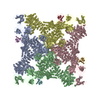


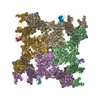
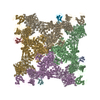


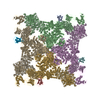
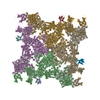
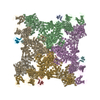

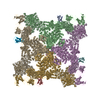
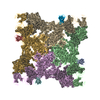
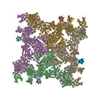

 PDBj
PDBj









